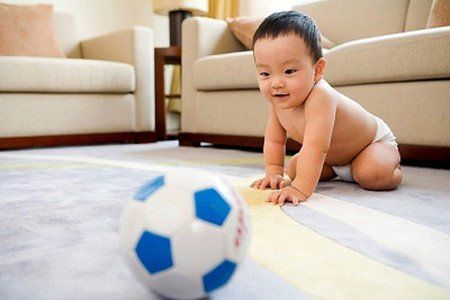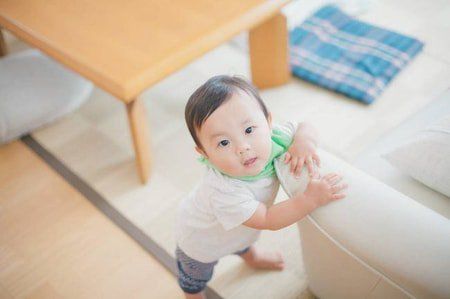This is an automatically translated article.
The article was professionally consulted by Specialist Doctor I Dang Thi Ngoc Chuong - Department of Pediatrics - Neonatology, Vinmec Central Park International General Hospital. The doctor has extensive experience in the diagnosis and examination of neonatal pathology - neonatal resuscitation.Baby's first year milestones can manifest quickly. The fact that the baby can sit up will open a new world, children can begin to play and explore completely new. This also makes mealtime easier and offers a new way to view your surroundings.
1. At what age do children sit up?
Your baby can sit up as early as 6 months with a little help, the average age of being able to sit is 4 to 7 months. Independent sitting is a skill many babies master between 7 and 9 months of age. Independent sitting gives your baby a new perspective on the world. Once your baby's back and neck muscles are strong enough to hold him upright and figure out where to put his feet so he won't tip over, he can then move on to crawling, standing, and walking.Your baby will masterly roll over and hold his head high. Most babies can sit well for a few minutes without support by the time they are 8 months old. (Even babies who have mastered sitting may still roll over, usually because they are not yet capable of standing upright.)
Trắc nghiệm: Sự phát triển tinh thần, vận động của bé thế nào là đúng chuẩn?
Khi nào bé biết nói, biết hóng chuyện hay biết cầm cốc là "đúng chuẩn"? Điểm xem bạn biết được bao nhiêu mốc phát triển tinh thần, vận động "đúng chuẩn" của bé nhé!The following content is prepared under supervision of Thạc sĩ, Bác sĩ y khoa, Ma Văn Thấm , Nhi , Phòng khám Đa khoa Quốc tế Vinmec Dương Đông(Phú Quốc)
2. Signs that your baby is ready to sit
While you can support your baby in a sitting position almost from day one, true independent sitting doesn't begin until your baby has head control. Starting at about 4 months of age, your baby's neck and head muscles strengthen rapidly, and he'll learn to hold his head high on his stomach.Baby may be ready to sit if head control is good. Other body movements will also be more controlled and purposeful. Babies who are ready to sit can also push themselves up on their stomachs and may have learned to turn over.
Babies can start by sitting for short periods of time if you place them upright. At this early stage, it is important to support the baby so that they do not fall.
Next, your child will figure out how to prop himself up on his arms and keep his chest on the ground, like a push-up. After 5 months of age, your baby can sit for a while without help, but you should stay nearby for support and put pillows around for cushioning to prevent your baby from falling.
Babies who are close to being able to sit on their own (approximately 7 to 9 months) will be able to roll in both directions. Some may even be pacing back and forth and preparing to crawl. Others may start in a sitting position with arms supported. In this position, the sitting baby is supported by one or both hands on the floor.
See more:

Baby soon learns to balance while sitting by leaning forward on one or both arms in a tripod position. By 7 months, your baby will probably be able to sit unsupported (this will free her hands to explore) and she'll learn to turn around to approach a desired object while sitting.
At this point, your baby can even go from tummy to sitting position by propping up his arms. By 8 months, your baby should be able to sit well without assistance.
3. What is the relationship between tummy time and sitting?
Tummy time is an important factor in sitting. If your baby doesn't like being on his stomach for long periods of time, start with a few minutes a few times a day. Make sure your baby is well rested and swaddled cleanly. Parents should also lie on their stomach so that you are at eye level with the baby. Seeing your face can motivate your baby to stay in the same position for longer. You can also try placing a mirror on the floor so your baby can see his or her own face.4. How to help your baby sit up
Practice makes perfect, so giving your baby the opportunity to sit upright can help her gain the strength to sit independently. Independent sitting requires controlled weight shifts from left, right, forward and backward. This means it takes a lot of effort and practice moving in all different directions to get it right.Head and chest lifts help strengthen the neck muscles and develop the head control needed to sit up. You can help by encouraging your child to play face down on the floor and then prompting him to look up.
Using noise-making toys or mirrors is also a good way to ensure that your child's hearing and vision are on the right track. Once your baby is pretty confident, place toys and other interesting objects within easy reach - they'll capture your baby's attention as she learns to balance with her arms.

Once they're a little more independent, place pillows or other cushions around them while you supervise them on the floor, not on elevated surfaces. Especially when your baby is just learning to sit up, remember to stay close in case she falls - or wants to show off her new skill. Have your child practice the experiment several times. Stay close, but let them explore and experiment with different approaches and body movements.
5. Can a child use a child restraint?
You may have seen different types of baby seats on the market. The Bumbo Chair, for example, is a popular choice among parents and is suitable for babies between 3 and 9 months old, or as soon as they can hold their heads high. It is made from molded material that wraps around the child's body to support sitting.Pediatric physical therapist Rebecca Talmud explains that being placed in a sitting position too soon or for long periods of time can hinder a child's development of skills. In other words, while babies can't really sit up yet, they don't yet have the ability to control their bodies and heads. These are important conditions to help children develop well and can begin to transition to new movements and positions.
You should wait until your baby is close to reaching the sitting milestone to use the baby seat. Instead of encouraging your baby to sit at 3 months of age, consider waiting until 6 to 8 months. And don't rely on this chair as the sole tool for exercise.
6. Sit safely
When your baby is just learning to sit with support, you should have her sit between her legs so you can support her on all sides. You can also use pillows, but don't leave your baby unattended when learning to sit.Although your baby may not be moving around yet, when he starts to sit is a sign that you need to shield hard, sharp objects in your home in preparation for the baby will soon move more.
You should use outlet covers in all rooms where your baby frequents. Make sure items or areas are in the right places. You can find things like cabinet locks, toilet locks, hangers, railings, and other child protection items at most stores. Keep all choking hazards, hazardous materials and other hazardous items out of the reach of babies. You can even lie on the floor level with your baby to look for potential hazards. Once babies learn to sit, adjust the height of their bassinet to a higher height. When the child pulls up, it will not exceed the height of the crib. At this point, babies safely practice their motor skills at different times of the day, even when they should be going to bed. Fasten seat belts when children are in highchairs and other seating devices. Sitting independently takes a lot of strength. Your baby may need extra support from the belt, especially when sitting for long periods of time. And do not place the chair on high surfaces, in or near water.

7. What should you do if you suspect your child has a developmental delay?
If your baby isn't sitting on his own by 9 months, contact your pediatrician. It may be good to take action earlier, especially if your baby is nearing 9 months and cannot sit with support. If your baby can't raise his head steadily by about 4 months and hasn't started learning to put his hands on the floor or can't sit up by 9 months talk to your doctor for help. help.Development varies between babies, but this can be a sign of a gross motor skill delay.
Other possible signs of delay include:
Stiffness or muscle tension Weak movements Hand to hand only No good head control Not reaching or bringing objects to mouth You should get help if you suspect your child may have a mental retardation. Talk to your doctor first. Newborns develop different skills, some more quickly than others, but head control is essential for independent sitting, and sitting is key to crawling, standing, and learning to walk.
Remember that premature babies may reach this and other milestones later than their peers.
8. After your child sits up, what milestones will he achieve next?
You can guess what happens after he realizes that he can lunge forward from a sitting position and balance on his hands and knees. Babies can begin to move forward (or backward) on all fours as early as 6 or 7 months, and mature crawling by 10 months. Children today are both active and curious, so keeping them warm is very important. It should be noted that, most pediatricians recommend waiting until your baby is sitting with minimal support before giving him solid foods. During the period when children learn to sit, parents should supplement their children with supporting products containing lysine, essential micro-minerals and vitamins such as zinc, chromium, selenium, and B vitamins to help fully meet their nutritional needs. substances in children. At the same time, these essential vitamins also support digestion, enhance nutrient absorption, help improve anorexia, help children eat well, and develop comprehensively.Please regularly visit Vinmec.com website and update useful information to take care of your baby and family.
Reference source: babycenter.com















